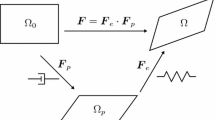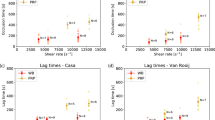Abstract
Normal blood clotting is vitally important for mammals. The diffusion-convection transfer of clotting factors plays a key role in blood clot formation. Since the shear rates of blood flow are very high (up to 7000 s−1), clot formation critically depends on the flow rate. The methods of study of the flow effect on clotting are indirect and the processes are rather complex; therefore, mathematical models of this process are significant for interpretation of results and understanding of the mechanisms. The review expounds the main experimental data on the effect of flow on the blood clotting cascade, some hypotheses and mathematical models explaining different regimes of the functioning of this system. The review is focused on specific problems encountered by researchers in this field. Some of the experimental works have shown that flow decreases the size of the formed fibrin clot and that the dependence of clot formation period on the flow shear rate is a threshold function. However, there are also experimental evidence that the flow can increase production of clotting factors (factor Xa), which must be expressed in the procoagulant action of the flow. Mathematical models of different aspects of clotting give no unified predictions either. Nevertheless, the combined analysis of results of detailed modeling and experiments, in our opinion, may result in understanding of the mechanisms, which determine the behavior of clotting in a flow.
Similar content being viewed by others
References
Schmidt, R., and Tews, G., Fiziologiya Cheloveka (Human Physiology), vol. 2, Moscow, Mir, 1996.
Colman, R.W., Hirsh, J., Marde, V.J., and Saltzman, E.W., Hemostasis and Thrombosis: Basic Principles and Clinical Practice, Philadelphia, Lippincott Company, 1994.
Butenas, S., Branda, R.F., Van’t Veer, C., Cawthern, K.M., and Mann, K.G., Platelets and Phospholipids in Tissue Factor-Initiated Thrombin Generation, Thromb. Haemost., 2001, vol. 86, no. 2, pp. 660–667.
Mann, K.G., Brumme, K., and Butenas, S. What Is All That Thrombin for? J. Thromb. Haemost., 2003, vol. 1, no. 7, pp. 1504–1514.
Butenas, S. and Mann, K.G., Blood Coagulation, Biochemistry (Mosc.), 2002, vol. 67, no. 1, pp. 3–12.
Turitto, V.T. and Hall, C.L., Mechanical Factors Affecting Hemostasis and Thrombosis, Thromb. Res., 1998, vol. 92, no. 6, Suppl. 2, pp. 25–31.
Caro, C.G., Pedley, I.J., and Seed, W.A., Cardiovascular Physiology, Mechanics of Circulation, Guylon, A.C., Ed., London, Medical and Technical Publ., 1974.
Baluda, V.P., Baluda, M.V., Deyanov, I.I., and Tlepshukov, I.L., Fiziologiya Sistemy Gemostaza (Hemostasis System Physiology), Moscow, Meditsina, 1995.
Brumme, K., Paradis, S.G., Butenas, S., and Mann, K.G., Thrombin Functions during Tissue Factor-Induced Blood Coagulation, Blood, 2002, vol. 100, no. 1, pp. 148–152.
Butenas, S. and Mann, K.G., Kinetics of Human Factor VII Activation, Biochemistry, 1996, vol. 35, no. 6, pp. 1904–1910.
Hill-Eubanks, D.C. and Lollar, P., Von Willebrand Factor Is a Cofactor for Thrombin-Catalyzed Cleavage of the Factor VIII Light Chain, J. Biol. Chem., 1990, vol. 265, no. 29, pp. 17854–17858.
Monkovic, D.D. and Tracy, P.B., Activation of Human Factor V by Factor Xa and Thrombin, Biochemistry, 1990, vol. 29, no. 5, pp. 1118–1128.
Baugh, R.J., Broze, G.J., Jr., and Krishnaswamy, S., Regulation of Extrinsic Pathway Factor Xa Formation by Tissue Factor Pathway Inhibitor, J. Biol. Chem., 1998, vol. 273, no. 8, pp. 4378–4386.
Bajaj, M.S., Birktoft, J.J., Steer, S.A., and Bajaj, S.P., Structure and Biology of Tissue Factor Pathway Inhibitor, Thromb. Haemost., 2001, vol. 86, pp. 959–972.
Weiss, H.J., Turitto, V.T., and Baumgartner, H.R., Role of Shear Rate and Platelets in Promoting Fibrin Formation on Rabbit Subendothelium. Studies Utilizing Patients with Quantitative and Qualitative Platelet Defects, J. Clin. Invest., 1986, vol. 78, no. 4, pp. 1072–1082.
Tonda, R., Galan, A.M., Mazzara, R., White, J.G., Ordinas, A., and Escolar, G., Platelet Membrane Fragments Enhance the Procoagulant Effect of Recombinant Factor VIIa in Studies with Circulating Human Blood under Conditions of Experimental Thrombocytopenia, Semin. Hematol., 2004, vol. 41, no. 1, Suppl. 1, pp. 157–162.
Shen, F., Kastrup, C.J., Liu, Y., and Ismagilov, R.F., Threshold Response of Initiation of Blood Coagulation by Tissue Factor in Patterned Microfluidic Capillaries Is Controlled by Shear Rate, Arterioscler. Thromb. Vasc. Biol., 2008, vol. 28, no. 11, pp. 2035–2041.
Katoh, S., Matsubara, I., and Sada, E., Effect of Shear Rate on Activation Rate of Factor X, Ann. Biomed. Eng., 1978, vol. 6, no. 1, pp. 60–67.
Andree, H.A., Contino, P.B., Repke, D., Gentry, R., and Nemerson, Y., Transport Rate Limited Catalysis on Macroscopic Surfaces: The Activation of Factor X in a Continuous Flow Enzyme Reactor, Biochemistry, 1994, vol. 33, no. 14, pp. 4368–4374.
Hathcock, J.J., Rusinova, E., Gentry, R.D., Andree, H., and Nemerson, Y., Phospholipid Regulates the Activation of Factor X by Tissue Factor/Factor VIIa (TF/VIIa) VIa Substrate and Product Interactions, Biochemistry, 2005, vol. 44, no. 22, pp. 8187–8197.
Hathcock, J., Rusinova, E., Vaananen, H., and Nemerson, Y., Lipid-Bound Factor Xa Regulates Tissue Factor Activity, Biochemistry, 2007, vol. 46, no. 20, pp. 6134–6140.
Xu, Z., Chen, N., Kamocka, M.M., Rosen, E.D., and Alber, M., A Multiscale Model of Thrombus Development, J. R. Soc. Interface, 2008, vol. 5, no. 24, pp. 705–722.
Anand, M., Rajagopal, K., and Rajagopal, K.R., A Model Incorporating Some of the Mechanical and Biochemical Factors Underlying Clot Formation and Dissolution in Flowing Blood, Comp. Math. Meth. Med., 2003, vol. 5, nos. 3–4, pp. 183–218.
Kuharsky, A.L. and Fogelson, A.L., Surface-Mediated Control of Blood Coagulation: The Role of Binding Site Densities and Platelet Deposition, Biophys. J., 2001, vol. 80, no. 3, pp. 1050–1074.
Fogelson, A.L. and Tania, N., Coagulation under Flow: The Influence of Flow-Mediated Transport on the Initiation and Inhibition of Coagulation, Pathophysiol. Haemost. Thromb., 2005, vol. 34, no. 2–3, pp. 91–108.
Beltrami, E. and Jesty, J., The Role of Membrane Patch Size and Flow in Regulating a Proteolytic Feedback Threshold on a Membrane: Possible Application in Blood Coagulation, Math. Biosci., 2001, vol. 172, no. 1, pp. 1–13.
Ermakova, E.A., Panteleev, M.A., and Shno, E.E., Blood Coagulation and Propagation of Autowaves in Flow, Pathophysiol. Haemost. Thromb., 2005, vol. 34, no. 2–3, pp. 135–142.
Zarnitsina, V.I., Pokhilko, A.V., and Ataullakhanov, F.I., A Mathematical Model for the Spatio-Temporal Dynamics of Intrinsic Pathway of Blood Coagulation. I. The Model Description, Thromb. Res., 1996, vol. 84, no. 4, pp. 225–236.
Anand, M. and Rajagopal, K.R., A Shear-Thinning Viscoelastic Model for Describing the Flow of Blood, Int. J. Cardiovasc. Med. Sci., 2004, vol. 4, no. 2, pp. 59–68.
Guy, R.D., Fogelson, A.L., and Keener, J.P., Fibrin Gel Formation in a Shear Flow, Math. Med. Biol., 2007, vol. 24, no. 1, pp. 111–130.
Author information
Authors and Affiliations
Corresponding author
Additional information
Original Russian Text © A.M. Shibeko, S.S. Karamzin, A.A. Butylin, M.A. Panteleev, F.I. Ataullakhanov, 2009, published in Biologicheskie Membrany, 2009, Vol. 26, No. 6, pp. 443–450.
The article was translated by the authors.
Rights and permissions
About this article
Cite this article
Shibeko, A.M., Karamzin, S.S., Butylin, A.A. et al. The review of contemporary ideas about the influence of flow rate on blood clotting. Biochem. Moscow Suppl. Ser. A 3, 388–394 (2009). https://doi.org/10.1134/S1990747809040047
Received:
Accepted:
Published:
Issue Date:
DOI: https://doi.org/10.1134/S1990747809040047




